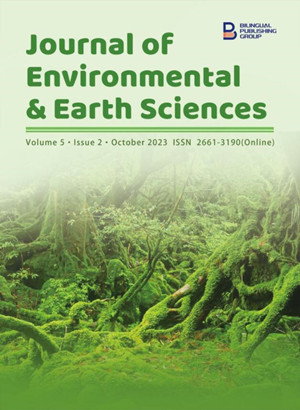
Energy Emissions Profile and Floating Solar Mitigation Potential for a Malaysia's State
DOI:
https://doi.org/10.30564/jees.v5i2.5923Abstract
The establishment of the National Low Carbon City Master Plan (NLCCM) by Malaysia's government presents a significant opportunity to minimize carbon emissions at the subnational or local scales, while simultaneously fostering remarkable economic potential. However, the lack of data management and understanding of emissions at the subnational level are hindering effective climate policies and planning to achieve the nationally determined contribution and carbon neutrality goal. There is an urgent need for a subnational emission inventory to understand and manage subnational emissions, particularly that of the energy sector which contribute the biggest to Malaysia's emission. This research aims to estimate carbon emissions for Selangor state in accordance with the Global Protocol for Community-Scale Greenhouse Gas Emission Inventories (GPC), for stationary energy activities. The study also evaluates the mitigation potential of Floating Solar Photovoltaic (FSPV) proposed for Selangor. It was found that the total stationary energy emission for Selangor for the year 2019 was 18,070.16 ktCO2e, contributed the most by the Manufacturing sub-sector (40%), followed by the Commercial and Institutional sub-sector; with 82% contribution coming from the Scope 2 emission. The highest sub-sector of Scope 1 emissions was contributed by Manufacturing while Scope 2 emissions from the Commercial and Institutional. Additionally, the highest fuel consumed was natural gas, which amounted to 1404.32 ktCO2e (44%) of total emissions. The FSPV assessment showed the potential generation of 2.213 TWh per year, by only utilizing 10% of the identified available ponds and dams in Selangor, equivalent to an emission reduction of 1726.02 ktCO2e, offsetting 11.6% Scope 2 electricity emission. The results from the study can be used to better evaluate existing policies at the sub-national level, discover mitigation opportunities, and guide the creation of future policies.
Keywords:
Greenhouse gas emission; Floating solar; GPC protocol; Stationary energy; Low carbon stateReferences
[1] Climate Change: A Threat to Human Wellbeing and Health of the Planet. Taking Action Now Can Secure Our Future [Internet]. IPCC; 2022 [cited 2022 Dec 25]. Available from: https://www.ipcc.ch/2022/02/28/pr-wgii-ar6/
[2] Understanding Global Warming Potentials [Internet]. EPA; 2022 [cited 2023 Jan 2]. Available from: https://www.epa.gov/ghgemissions/understanding-global-warming-potentials
[3] Intergovernmental Panel on Climate Change (IPCC), 2022. Summary for policymakers. Global warming of 1.5 °C: IPCC special report on impacts of global warming of 1.5 °C above pre-industrial levels in context of strengthening response to climate change, sustainable development, and efforts to eradicate poverty. Cambridge University Press: Cambridge. pp. 1-24. DOI: https://doi.org/10.1017/9781009157940.001
[4] Rogelj, J., Shindell, D., Jiang, K., et al., 2018. Mitigation Pathways Compatible with 1.5°C in the Context of Sustainable Development [Internet] [cited 2022 Dec 2]. Available from: https://www.ipcc.ch/site/assets/uploads/sites/2/2019/02/SR15_Chapter2_Low_Res.pdf
[5] Solar PV Global Supply Chains [Internet]. IEA; 2022. Available from: https://www.iea.org/reports/solar-pv-global-supply-chains
[6] Green Technology Master Plan Malaysia 2017-2030 [Internet]. Ministry of Energy, Green Technology and Water Malaysia (KeTTHA); 2017 [cited 2022 Dec 2]. Available from: https://www.pmo.gov.my/wp-content/uploads/2019/07/Green-Technology-Master-Plan-Malaysia-2017-2030.pdf
[7] National Low Carbon Cities Masterplan [Internet]. Ministry of Environment and Water (KASA); 2021 [cited 2022 Dec 2]. Available from: https://www.nrecc.gov.my/ms-my/teras/alamsekitar/Documents/NLCCM.pdf
[8] Abdul-Azeez, I.A., 2020. Low carbon development through measuring and monitoring carbon emission in Johor Bahru, Malaysia. Journal of Environmental Treatment Techniques. 9(1), 242-252.
[9] Rahman, H.A., 2020. Malaysia commitment towards low carbon cities. International Journal of Academic Research in Business and Social Sciences. 10(15), 253-266. DOI: https://doi.org/10.6007/ijarbss/v10-i15/8247
[10] Breyer, C., Koskinen, O., Blechinger, P., 2015. Profitable climate change mitigation: The case of greenhouse gas emission reduction benefits enabled by solar photovoltaic systems. Renewable and Sustainable Energy Reviews. 49, 610-628. DOI: https://doi.org/10.1016/j.rser.2015.04.061
[11] Gorjian, S., Sharon, H., Ebadi, H., et al., 2021. Recent technical advancements, economics and environmental impacts of floating photovoltaic solar energy conversion systems. Journal of Cleaner Production. 278, 124285. DOI: https://doi.org/10.1016/j.jclepro.2020.124285
[12] Dehghanimadvar, M., Egan, R., Chang, N.L., 2022. Economic assessment of local solar module assembly in a global market. Cell Reports Physical Science. 3(2). DOI: https://doi.org/10.1016/j.xcrp.2022.100747
[13] Jamalludin, M.A.S., Muhammad-Sukki, F., Abu-Bakar, S.H., et al., 2019. Potential of floating solar technology in Malaysia. International Journal of Power Electronics and Drive Systems (IJPEDS). 10(3), 1638-1644. DOI: https://doi.org/10.11591/ijpeds.v10.i3.pp1638-1644
[14] Mohammad, S.T., Al-Kayiem, H.H., Aurybi, M.A., et al., 2020. Measurement of global and direct normal solar energy radiation in Seri Iskandar and comparison with other cities of Malaysia. Case Studies in Thermal Engineering. 18, 100591. DOI: https://doi.org/10.1016/j.csite.2020.100591
[15] GHG Protocol for Cities [Internet]. GPC; 2014 [cited 2022 Nov 2]. Available from: https://ghgprotocol.org/greenhouse-gas-protocol-accounting-reporting-standard-cities
[16] Dahal, K., Niemelä, J., 2017. Cities' greenhouse gas accounting methods: A study of Helsinki, Stockholm, and Copenhagen. Climate. 5(2), 31. DOI: https://doi.org/10.3390/cli5020031
[17] Dodman, D., 2009. Blaming cities for climate change? An analysis of urban greenhouse gas emissions inventories. Environment and Urbanization. 21(1), 185-201. DOI: https://doi.org/10.1177/0956247809103016
[18] Malaysia Third Biennial Update Report to the UNFCCC [Internet]. Unfccc.int; 2020 [cited 2022 Dec 23]. Available from: https://unfccc.int/sites/default/files/resource/MALAYSIA_BUR3-UNFCCC_Submission.pdf
[19] Malaysia's Update of Its First Nationally Determined Contribution [Internet] [cited 2022 Dec 2]. Available from: https://unfccc.int/NDCREG
[20] Ministry of Economy Department of Statistics Malaysia Official Portal [Internet]. Available from: https://www.dosm.gov.my/v1/index.php?r=column/cthemeByCat&cat=491&bul_id=L3NnMU44VnA0YjRxVXhuYUpZTmVnZz09&menu_id=TE5CRUZCblh4ZTZMODZIbmk2aWRRQT09
[21] Population and Housing Census of Malaysia 2020 [Internet]. Department of Statistic Malaysia; 2020. Available from: https://www.selangor.gov.my/sabakbernam/resources/PENERBITAN_PENEMUAN_UTAMA_BANCI_PENDUDUK_DAN_PERUMAHAN_MALAYSIA_2020.pdf
[22] Current Population Estimates, Malaysia [Internet]. eStatistic; 2019. Available from: https://newss.statistics.gov.my/newss-portalx/ep/epProductFreeDownloadSearch.seam
[23] National Energy Balance 2019 [Internet]. Suruhanjaya Tenaga (Energy Commission); 2019 [cited 2023 Mar 1]. Available from: https://meih.st.gov.my/documents/10620/19759/National+Energy+Balance+2019
[24] Grid Emission Factor (GEF) in Malaysia [Internet]. Energy Commissioner; 2019 [cited 2023 Jan 2]. Available from: https://meih.st.gov.my/publications
[25] Alternative Water Source Profile [Internet]. LUAS Selangor [cited 2022 Dec 5]. Available from: https://www.luas.gov.my/en/water-resource-info/alternative-water-source-profile
[26] Solar Resource Maps of Malaysia [Internet]. Solargis; 2022 [cited 2023 Jan 2]. Available from: https://solargis.com/maps-and-gis-data/download/malaysia
[27] Global Horizontal Irradiation. Global Solar Atlas [Internet]. Solargis; 2023 [cited 2023 Jan 5]. Available from: https://www.globalsolaratlas.info/map?c=2.836403%2C101.496506%2C11&s=2.836562%2C101.496182&m=site
[28] Abu Samad, I.A., 2020. 3 Easy Steps to Estimate Solar Size [Internet]. TNBX [cited 2023 Jan 5]. Available from: https://www.tnbx.com.my/post/3-easy-steps-to-estimate-solar-size
[29] Tiger Pro 72HC 530-550-Watt Mono-Facial Module Catalogue [Internet]. Jinko Solar; 2020. Available from: https://www.jinkosolar.com/uploads/5ff587a0/JKM530-550M-72HL4-(V)-F1-EN.pdf
Downloads
How to Cite
Issue
Article Type
License
Copyright © 2023 Author(s)

This is an open access article under the Creative Commons Attribution-NonCommercial 4.0 International (CC BY-NC 4.0) License.







 Suraya Nabilah Zaini
Suraya Nabilah Zaini






